反义疑问句讲解
- 格式:docx
- 大小:11.31 KB
- 文档页数:5
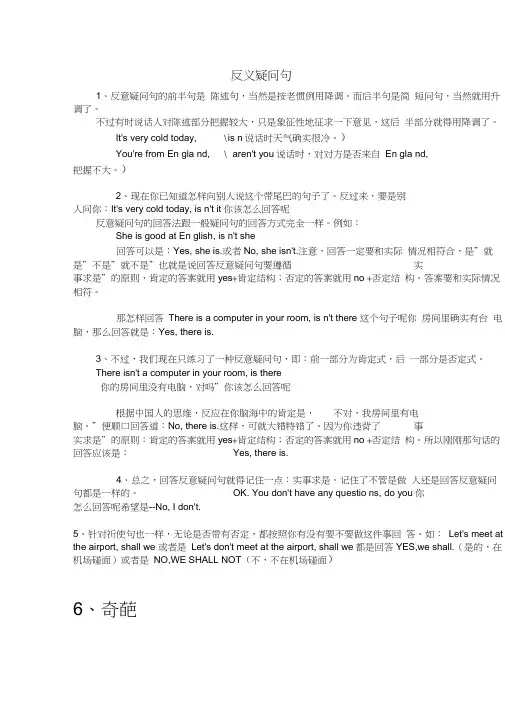
反义疑问句1、反意疑问句的前半句是陈述句,当然是按老惯例用降调。
而后半句是简短问句,当然就用升调了。
不过有时说话人对陈述部分把握较大,只是象征性地征求一下意见,这后半部分就得用降调了。
It's very cold today, \is n说话时天气确实很冷。
)You're from En gla nd, \ aren't you说话时,对对方是否来自En gla nd,把握不大。
)2、现在你已知道怎样向别人说这个带尾巴的句子了。
反过来,要是别人问你:It's very cold today, is n't it你该怎么回答呢反意疑问句的回答法跟一般疑问句的回答方式完全一样。
例如:She is good at En glish, is n't she回答可以是:Yes, she is.或者No, she isn't.注意,回答一定要和实际情况相符合,是”就是”不是”就不是”也就是说回答反意疑问句要遵循实事求是”的原则,肯定的答案就用yes+肯定结构;否定的答案就用no +否定结构。
答案要和实际情况相符。
那怎样回答There is a computer in your room, is n't there 这个句子呢你房间里确实有台电脑,那么回答就是:Yes, there is.3、不过,我们现在只练习了一种反意疑问句,即:前一部分为肯定式,后一部分是否定式。
There isn't a computer in your room, is there你的房间里没有电脑,对吗”你该怎么回答呢根据中国人的思维,反应在你脑海中的肯定是,不对,我房间里有电脑。
”便顺口回答道:No, there is.这样,可就大错特错了。
因为你违背了事实求是”的原则:肯定的答案就用yes+肯定结构;否定的答案就用no +否定结构。
所以刚刚那句话的回答应该是:Yes, there is.4、总之,回答反意疑问句就得记住一点:实事求是。
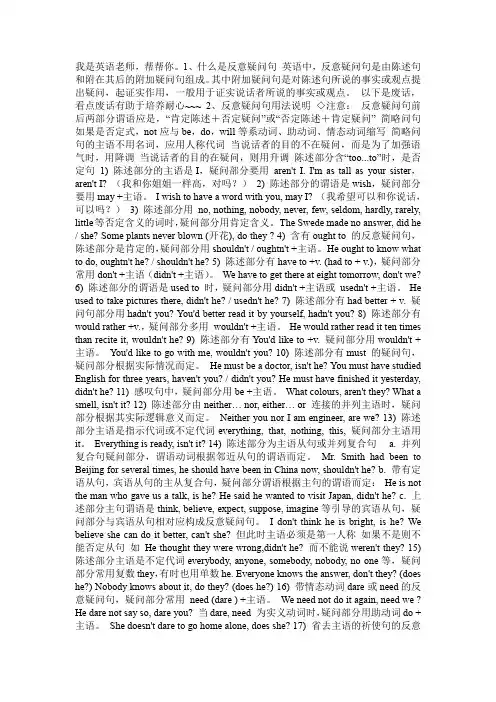
我是英语老师,帮帮你。
1、什么是反意疑问句英语中,反意疑问句是由陈述句和附在其后的附加疑问句组成。
其中附加疑问句是对陈述句所说的事实或观点提出疑问,起证实作用,一般用于证实说话者所说的事实或观点。
以下是废话,看点废话有助于培养耐心~~~ 2、反意疑问句用法说明◇注意:反意疑问句前后两部分谓语应是,“肯定陈述+否定疑问”或“否定陈述+肯定疑问” 简略问句如果是否定式,not应与be,do,will等系动词、助动词、情态动词缩写简略问句的主语不用名词,应用人称代词当说话者的目的不在疑问,而是为了加强语气时,用降调当说话者的目的在疑问,则用升调陈述部分含“too...to”时,是否定句1) 陈述部分的主语是I,疑问部分要用aren't I. I'm as tall as your sister,aren't I? (我和你姐姐一样高,对吗?)2) 陈述部分的谓语是wish,疑问部分要用may +主语。
I wish to have a word with you, may I? (我希望可以和你说话,可以吗?)3) 陈述部分用no, nothing, nobody, never, few, seldom, hardly, rarely, little等否定含义的词时,疑问部分用肯定含义。
The Swede made no answer, did he / she? Some plants never blown (开花), do they ? 4) 含有ought to 的反意疑问句,陈述部分是肯定的,疑问部分用shouldn't / oughtn't +主语。
He ought to know what to do, oughtn't he? / shouldn't he? 5) 陈述部分有have to +v. (had to + v.),疑问部分常用don't +主语(didn't +主语)。
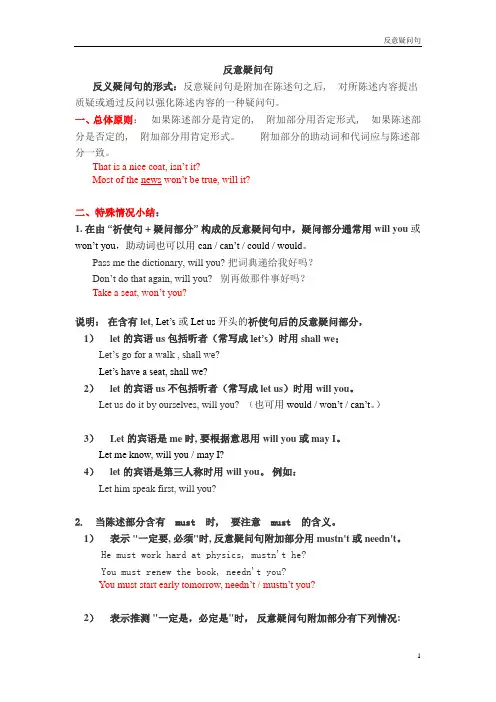
反意疑问句反义疑问句的形式:反意疑问句是附加在陈述句之后, 对所陈述内容提出质疑或通过反问以强化陈述内容的一种疑问句。
一、总体原则:如果陈述部分是肯定的, 附加部分用否定形式, 如果陈述部分是否定的, 附加部分用肯定形式。
附加部分的助动词和代词应与陈述部分一致。
That is a nice coat, isn’t it?Most of the news won’t be true, will it?二、特殊情况小结:1. 在由“祈使句 + 疑问部分”构成的反意疑问句中,疑问部分通常用will you或won’t you,助动词也可以用can / can’t / could / would。
Pass me the dictionary, will you? 把词典递给我好吗?Don’t do that again, will you?别再做那件事好吗?Take a seat, won’t you?说明:在含有let, Let’s或Let us开头的祈使句后的反意疑问部分,1)let的宾语us包括听者(常写成let’s)时用shall we;Let’s go for a walk , shall we?Let’s have a seat, shall we?2)let的宾语us不包括听者(常写成let us)时用will you。
Let us do it by ourselves, will you? (也可用would / won’t / can’t。
)3)Let的宾语是me时, 要根据意思用will you或may I。
Let me know, will you / may I?4)let的宾语是第三人称时用will you。
例如:Let him speak first, will you?2. 当陈述部分含有 must 时, 要注意 must 的含义。
1)表示 "一定要, 必须"时, 反意疑问句附加部分用 mustn't 或 needn't。
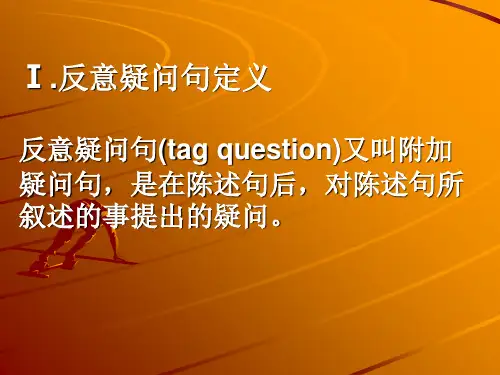
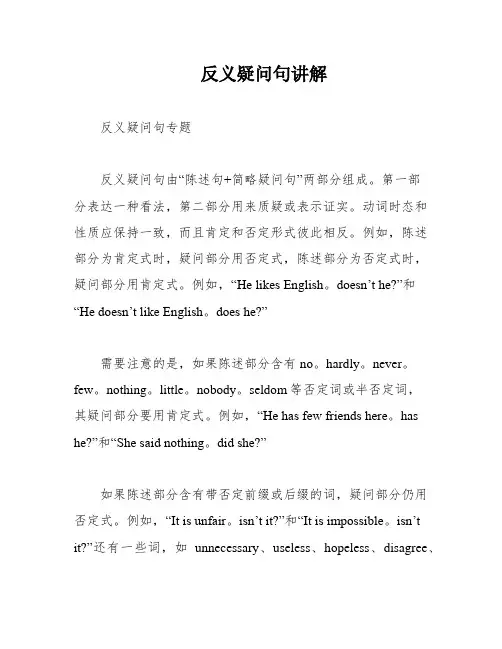
反义疑问句讲解反义疑问句专题反义疑问句由“陈述句+简略疑问句”两部分组成。
第一部分表达一种看法,第二部分用来质疑或表示证实。
动词时态和性质应保持一致,而且肯定和否定形式彼此相反。
例如,陈述部分为肯定式时,疑问部分用否定式,陈述部分为否定式时,疑问部分用肯定式。
例如,“He likes English。
doesn’t he?”和“He doesn’t like English。
does he?”需要注意的是,如果陈述部分含有no。
hardly。
never。
few。
nothing。
little。
nobody。
seldom等否定词或半否定词,其疑问部分要用肯定式。
例如,“He has few friends here。
has he?”和“She said nothing。
did she?”如果陈述部分含有带否定前缀或后缀的词,疑问部分仍用否定式。
例如,“It is unfair。
isn’t it?”和“It is impossible。
isn’t it?”还有一些词,如unnecessary、useless、hopeless、disagree、impolite、unfinished、unequal、misunderstand、antisocial、incorrect等也属于这一类。
当陈述部分为there be句型时,疑问部分仍用there作“主语”。
例如,“There was nothing in the room。
was there?”当陈述部分的主语是指示代词或复合不定代词(this。
that。
everything。
something。
nothing。
anything。
these。
those。
someone。
everyone。
everybody。
somebody。
no one。
nobody)时,疑问部分用it、they等代词。
例如,“That is a new car。
isn’t it?”和“Everything is ready。
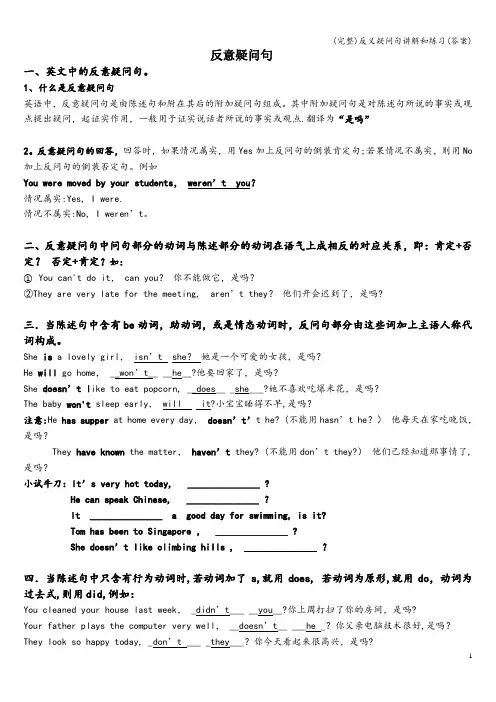
反意疑问句一、英文中的反意疑问句。
1、什么是反意疑问句英语中,反意疑问句是由陈述句和附在其后的附加疑问句组成。
其中附加疑问句是对陈述句所说的事实或观点提出疑问,起证实作用,一般用于证实说话者所说的事实或观点.翻译为“是吗”2。
反意疑问句的回答,回答时,如果情况属实,用Yes加上反问句的倒装肯定句;若果情况不属实,则用No 加上反问句的倒装否定句。
例如You were moved by your students,weren’t you?情况属实:Yes, I were.情况不属实:No, I weren’t。
二、反意疑问句中问句部分的动词与陈述部分的动词在语气上成相反的对应关系,即:肯定+否定?否定+肯定?如:①You can't do it, can you?你不能做它,是吗?②They are very late for the meeting, aren’t they?他们开会迟到了,是吗?三.当陈述句中含有be动词,助动词,或是情态动词时,反问句部分由这些词加上主语人称代词构成。
She is a lovely girl,isn’t she?她是一个可爱的女孩,是吗?He will go home, __won’t__ __he__?他要回家了,是吗?She doesn’t l ike to eat popcorn, __does__ _she___?她不喜欢吃爆米花,是吗?The baby won't sleep early, will it?小宝宝睡得不早,是吗?注意:He has supper at home every day,doesn’t’t he? (不能用hasn’t he?)他每天在家吃晚饭,是吗?They have known the matter,haven’t they? (不能用don’t they?)他们已经知道那事情了,是吗?小试牛刀:It’s very hot today, _______________ ?He can speak Chinese, _______________ ?It _______________ a good day for swimming, is it?Tom has been to Singapore , _______________ ?She do esn’t like climbing hills , _______________ ?四.当陈述句中只含有行为动词时,若动词加了s,就用does, 若动词为原形,就用do,动词为过去式,则用did,例如:You cleaned your house last week, _didn’t___ __you__?你上周打扫了你的房间,是吗?Your father plays the computer very well, __doesn’t__ ___he _?你父亲电脑技术很好,是吗?They look so happy today, _don’t ___ _they___?你今天看起来很高兴,是吗?小试牛刀: Meimei studies in a middle school, _______________ ?He loves cold weather , _______________ ?You finished the task yesterday, _______________ ?五.反意疑问句的陈述部分带有little, few, never, hardly, seldom,nobody, nothing,barely, scarcely等否定意义的词时,问句部分用肯定式.如:①She never tells a lie, does she?(不用doesn’t she?)她从不说谎,是吗?②He was seldom late, was he?(不用wasn’t he?) 他几乎不迟到,是吗?小试牛刀:Few students can answer the question, _______________ ?He can hardly finish his homework, _______________ ?六、反意疑问句的陈述部分为I am……时,问句部分习惯上用aren’t I?表示.如:I am a very honest man, aren’t I? 我是个很诚实的人,是吗?小试牛刀:I’m in Class 3,Grade 2, _______________ ?I’m ten years old, _______________ ?七.陈述部分的主语为不定代词something, anything, nothing, everything时,问句部分的主语用it。
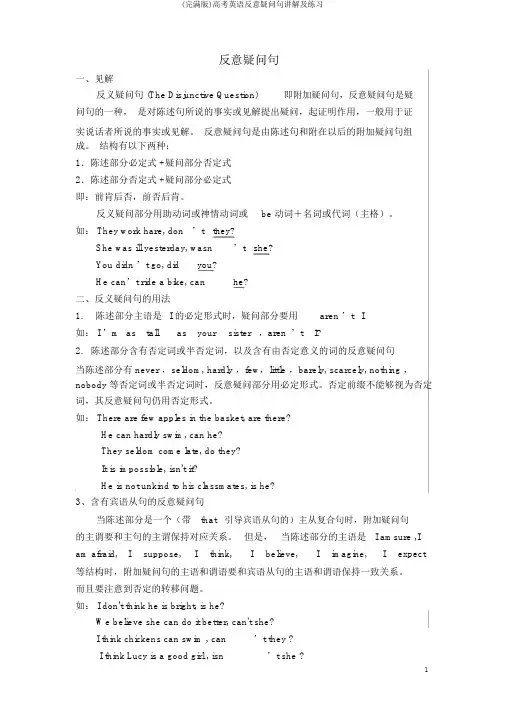
反意疑问句一、见解反义疑问句 (The Disjunctive Question)即附加疑问句,反意疑问句是疑问句的一种,是对陈述句所说的事实或见解提出疑问,起证明作用,一般用于证实说话者所说的事实或见解。
反意疑问句是由陈述句和附在以后的附加疑问句组成。
结构有以下两种:1.陈述部分必定式 +疑问部分否定式2.陈述部分否定式 +疑问部分必定式即:前肯后否,前否后肯。
反义疑问部分用助动词或神情动词或be 动词+名词或代词(主格)。
如: They work hare, don’t they?She was ill yesterday, wasn’t she?You didn ’t go, did you?He can’t ride a bike, can he?二、反义疑问句的用法1. 陈述部分主语是I 的必定形式时,疑问部分要用aren ’t I.如: I ’m as tall as your sister,aren’t I?2.陈述部分含有否定词或半否定词,以及含有由否定意义的词的反意疑问句当陈述部分有 never ,seldom, hardly ,few,little ,barely, scarcely, nothing ,nobody 等否定词或半否定词时,反意疑问部分用必定形式。
否定前缀不能够视为否定词,其反意疑问句仍用否定形式。
如: There are few apples in the basket, are there?He can hardly swim, can he?They seldom come late, do they?It is impossible, isn't it?He is not unkind to his classmates, is he?3、含有宾语从句的反意疑问句当陈述部分是一个(带that引导宾语从句的)主从复合句时,附加疑问句的主谓要和主句的主谓保持对应关系。
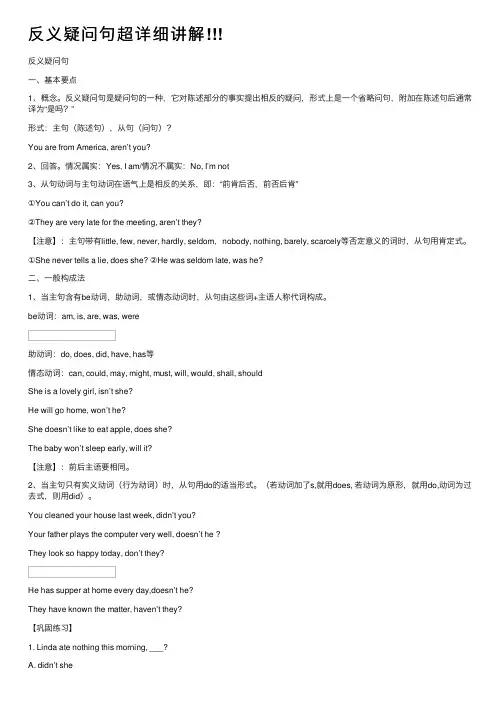
反义疑问句超详细讲解反义疑问句⼀、基本要点1、概念。
反义疑问句是疑问句的⼀种,它对陈述部分的事实提出相反的疑问,形式上是⼀个省略问句,附加在陈述句后通常译为“是吗?”形式:主句(陈述句),从句(问句)?You are from America, aren’t you?2、回答。
情况属实:Yes, I am/情况不属实:No, I’m not3、从句动词与主句动词在语⽓上是相反的关系,即:“前肯后否,前否后肯”①You can’t do it, can you?②They are very late for the meeting, aren’t they?【注意】:主句带有little, few, never, hardly, seldom,nobody, nothing, barely, scarcely等否定意义的词时,从句⽤肯定式。
①She never tells a lie, does she? ②He was seldom late, was he?⼆、⼀般构成法1、当主句含有be动词,助动词,或情态动词时,从句由这些词+主语⼈称代词构成。
be动词:am, is, are, was, were助动词:do, does, did, have, has等情态动词:can, could, may, might, must, will, would, shall, shouldShe is a lovely girl, isn’t she?He will go home, won’t he?She doesn’t like to eat apple, does she?The baby won’t sleep early, will it?【注意】:前后主语要相同。
2、当主句只有实义动词(⾏为动词)时,从句⽤do的适当形式。
(若动词加了s,就⽤does, 若动词为原形,就⽤do,动词为过去式,则⽤did)。
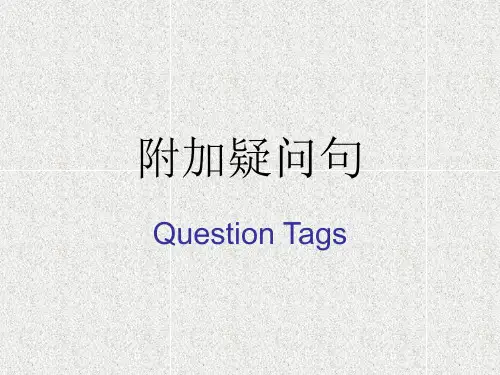
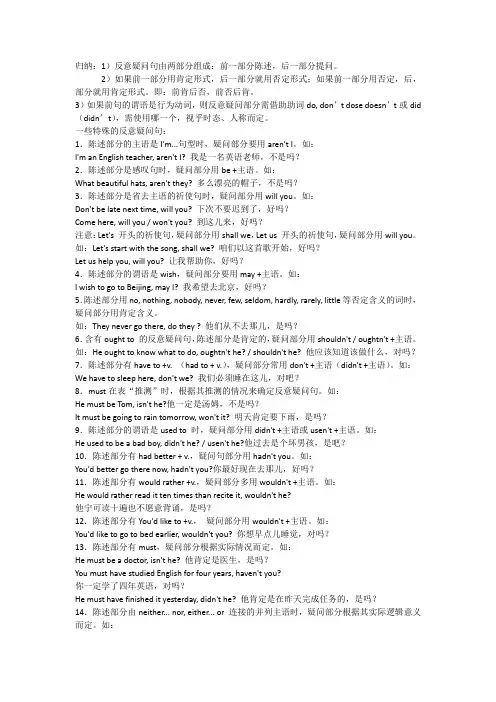
归纳:1)反意疑问句由两部分组成:前一部分陈述,后一部分提问。
2)如果前一部分用肯定形式,后一部分就用否定形式;如果前一部分用否定,后,部分就用肯定形式。
即:前肯后否,前否后肯。
3)如果前句的谓语是行为动词,则反意疑问部分需借助助词do, don’t dose doesn’t或did (didn’t),需使用哪一个,视乎时态、人称而定。
一些特殊的反意疑问句:1.陈述部分的主语是I'm...句型时,疑问部分要用aren't I。
如:I'm an English teacher, aren't I? 我是一名英语老师,不是吗?2.陈述部分是感叹句时,疑问部分用be +主语。
如:What beautiful hats, aren't they? 多么漂亮的帽子,不是吗?3.陈述部分是省去主语的祈使句时,疑问部分用will you。
如:Don't be late next time, will you? 下次不要迟到了,好吗?Come here, will you / won't you? 到这儿来,好吗?注意:Let's 开头的祈使句,疑问部分用shall we,Let us 开头的祈使句,疑问部分用will you。
如:Let's start with the song, shall we? 咱们以这首歌开始,好吗?Let us help you, will you? 让我帮助你,好吗?4.陈述部分的谓语是wish,疑问部分要用may +主语。
如:I wish to go to Beijing, may I? 我希望去北京,好吗?5.陈述部分用no, nothing, nobody, never, few, seldom, hardly, rarely, little等否定含义的词时,疑问部分用肯定含义。
如:They never go there, do they ?他们从不去那儿,是吗?6.含有ought to 的反意疑问句,陈述部分是肯定的,疑问部分用shouldn't / oughtn't +主语。

Everything is ready, isn't it?都准备好了,是吗?Nothing was said, was it ? 什么也没说,对吗?Nothing can stop us ,can it? 没有什么能阻止我们,是吗?(6)当陈述部分以不定代词one作主语,疑问部分的主语在正式的场合用one,在非正式场合用you。
One can’t be too careful, can one(you)?怎么细心都不为过,你说呢?One should learn from others, shouldn’t one(you)?人要想别人学习,是吗?(7)当陈述部分是“there be+主语+其它”结构时,疑问部分要用“be(not)+there”结构。
There is a book on the desk, isn't there?桌子上有本书,是吗?There used to be a lot of coal mines in the south, didn't there?过去在南部有大量煤矿,不是吗?(8)当陈述部分的主语是“I don’t think (suppose, believe)+that从句”结构时,疑问部分的主语和谓语须和从句中的主语和谓语在人称和数上相一致,并且还要用肯定形式。
I don’t suppose anyone will volunteer, will they?我认为没人会自愿去做,是吗?I don't think you've heard of him before, have you?我想你从前没听说过他,是吗?I think it is your duty to stick to the fighting post at any time, isn't it? 我认为无论何时坚持你的战斗岗位都是你的责任,对不?I don't suppose you are serious, are you? 我想你不是认真的,是吗?注意:主句的主语不是第一人称时I是不存在这种情况。
反意疑问句知识集结知识元反意疑问句知识讲解1.概念反义疑问句(The Disjunctive Question 或 Question tags)即附加疑问句.它表示提问人的看法,没有把握,需要对方赞同.2.结构:反义疑问句由两部分组成:前一部分是一个陈述句,后一部分是一个简短的疑问句,两部分的人称时态应保持一致.主要形式:陈述部分肯定式+疑问部分否定式;陈述部分否定式+疑问部分肯定式.1)陈述部分肯定句+疑问部分否定句(可记为前肯后否).例:They work hard, don't they?他们努力工作,不是吗?Let's go to the supermarket ,shall we?让我们去超市,好吗?2)陈述部分否定句+疑问部分肯定句(可记为前否后肯).例:You didn't go, did you?你没去,是吗?3.用法:1)反意疑问句的缩写问题当反意疑问句的附加部分为否定式时,习惯上只用缩写形式,不能分开来写.如:You love him very much, don't you?你很爱他,对不对?2)反意疑问句用于there be句式当陈述部分为there be句型时,附加部分仍用there be句式.如:There is a garden at the back of the house, isn't there?房子背后有一座花园,对吗?3)当 have 为助动词时,其反意疑问句沿用同样的助动词:He has already left, hasn't he?他已经离开了,是吗?4)当 have 为实意动词时,要分两种情况:①若表示"所有",反意疑问句可以用have,也可以用do:He has a lot of friends here, hasn't [doesn't] he?他在这儿有许多朋友,是吗?但是若陈述部分用的是have的否定式,反意疑问句用have 还是用do,取决于陈述部分的动词形式:He hasn't any money, has he?他没有钱,是吗?He doesn't have any money, does he?他没有钱,是吗?②若表示"吃"、"玩"等意思,反意疑问句要用do:He has supper at 5, doesn't he?他5点吃晚餐,是吗?He had a good time at the party, didn't he?他在晚会上玩得很开心,是吗?4)涉及情态动词的反意疑问句在通常情况下,当陈述部分含有情态动词时,反意疑问句会重复前面同样的情态动词.如:The boy can read and write, can't he?这男孩会读写,是吗?We shouldn't help him, should we?我们不应该帮助他,对吗?注意,当陈述部分含有情态动词must时,要分两种情况:若must表示"必须"或"有必要",则附加部分可用 mustn't 或needn't.如:You must leave at once, mustn't [needn't] you?他必须(有必要)马上离开,是吗?若must表示推测,意为"一定"时,其附加部分不能用must,而应根据must后的动词结构采用相应的动词形式.如:He must be tired, isn't he?他一定累了,是吗?He must have read it, hasn't [didn't] he?他一定读过它,是吗?He must have left yesterday, didn't he?他昨天一定走了,是吗?这三句中的must均表示推测,其意均表示"一定".第一句的must后为动词be,而句子为第三人称单数,所以附加部分用isn't he;第二句的must后为动词 read的完成式have read,表明动作已经发生过了,此时的附加部分既可与have保持一致使用hasn't he,也可与动词read何持一致使用didn't he;第三句的must后也是动词read的完成式,但由于它后面用了表示明确过去时间的状语,所以附加部分用didn't he,不用hasn't he.5)涉及祈使句的反意疑问句若陈述部分为祈使句,则其附加部分通常用will you, won't you, would you等.如:Come tomorrow, will you?明天来吧,好不好?Try it again, won't you?再试一次,好吗?但是,如果前面为否定的祈使句,则其附加问句部分要用肯定形式will you,而不能用否定式形式的won't.如:Don't tell him, will you?不要告诉他,好吗?注意,当祈使句Let's…或Let us…开头时,情况比较特殊﹣﹣由于Let's…总是表示建议,所以其后的附加部分总是用shall we.如:Let's have a break, shall we?我们休息一下吧,好不好?Let's meet on Monday, shall we?咱们星期一碰头吧,好不好?而祈使句以et us…时则有所不同,由于它有时表示请求,有时表示建议,所以要区别对待﹣﹣表示请求时,附加部分用will you;表示建议时,附加部分用shall we.如:Let us know your address, will you?请把你的地址告诉我们,好吗?Let us go swimming together, shall we?我们一起去游泳吧,好吗?4.易混淆点:1)反意疑问句的主语问题反意疑问句部分的主语应与陈述部分主语一致,且只能是代词,不能是名词.如:正:Jim likes English very much, doesn't he?吉姆很喜欢英语,对吗?如果陈述部分的主语是指示代词或不定代词等,在附加部分应改用相应的人称代词.如:That is a wallet, isn't it?这是个钱包,是吗?Nothing is serious, isn't it?一点也不严重,对吗?注意,如果陈述部分的主语为somebody, someone, everyone, everybody, no one, nobody 等指人的复合不定代词时,其附加部分的主语在正式文体中用he,在口语或非正式文体中通常用they.如:2)当陈述部分为否定式,反意疑问句为肯定式时,其回答往往与汉语不一致,需特别引起注意:"It isn't cheap, is it?" "Yes, it is." "它不便宜吧?""不,很便宜.""He doesn't love her, does he?" "No, he doesn't.""他不爱她,是吗?""是的,他不爱她." Nobody likes it, does he [don't they]?没有一个人喜欢它,是吗?5.解题方法点拨:回答反意疑问句的原则回答反意疑问句通常应根据实际情况来确定,如有人问你You are asleep, aren't you?你应回答No, I'm not.因为既然你能回答,肯定你还没有asleep.但如果别人问你 You aren't asleep, are you?(你还没有睡着,对吗),你也只能回答No, I'm not.(是的,还没有睡着),而不能回答为Yes, I'm not.也不能回答成 Yes, I am.6.高考命题方向:1)考查祈使句的反意疑问句Don't play football in the street, will you?不要在街上打篮球好吗?2)考查let's …的反意疑问句Let's go home together, shall we?我们一起回家好吗?3)考查陈述部分带有little, few, never, hardly, seldom等否定意义的词的反意疑问句He seldom takes a bus to school, does he?他很少乘公共汽车去学校,对吗?4)考查复合句的反意疑问句They said that you had finished your homework, didn't they?他们说你做完作业了,是吗?例题精讲反意疑问句例1.【答案】A【解析】题干解析:A 句中有never表示否定意义,排除BD.never后面是动词原形,可以推断本句是祈使句,祈使句的反义疑问句一般用will you。
反义疑问句一.句型解释反义疑问句(The Disjunctive Question):即附加疑问句。
它表示提问人的看法,没有把握,需要对方证实。
反义疑问句由两部分组成:前一部分是一个陈述句,后一部分是一个简短的疑问句,两部分的人称时态应保持一致。
1.陈述部分肯定式+疑问部分否定式2.陈述部分否定式+疑问部分肯定式She was ill yesterday, wasn’t she?You didn’t go, did you?二.特殊的句型1.祈使句。
祈使句后一般加上will you或won't you构成反意疑问句,用will you 多表示“请求”,用won't you 多表示提醒对方注意。
例如:Let引导的祈使句有两种情况:1) Let's...,后的反意疑问句用shall we或shan't we。
例如:Let's go home, shall we/ shan't we? 回家吧,好吗?2)Let us/me...后的反意疑问句用will you或won't you。
例如:Let me have a try, will you/won't you?3)祈使句都用will you 或won’t you2.当陈述部分含I think (believe, suppose...)that... 结构时,其反意疑问句须与从句的主、谓语保持一致,注意主句的主语必须是第一人称。
例如:I don't think he will come, will he?若是非第一人称,则与主句的主语相一致He thinks that she will come, doesn’t he?反意疑问句的陈述部分为I(We) don’t think(believe, suppose, consider)+ that从句时,从句为否定意义,问句部分的动词和主语仍与that从句保持一致且用肯定式。
反意疑问句一、概念反义疑问句(The Disjunctive Question) 即附加疑问句,反意疑问句是疑问句的一种,是对陈述句所说的事实或观点提出疑问,起证实作用,一般用于证实说话者所说的事实或观点。
反意疑问句是由陈述句和附在其后的附加疑问句组成。
结构有以下两种:1.陈述部分肯定式+疑问部分否定式2.陈述部分否定式+疑问部分肯定式即:前肯后否,前否后肯。
反义疑问部分用助动词或情态动词或be动词+名词或代词(主格)。
如:They work hare, don’t they?Sh e was ill yesterday, wasn’t she?You didn’t go, did you?He can’t ride a bike, can he?二、反义疑问句的用法1. 陈述部分主语是I的肯定形式时,疑问部分要用aren’t I.如:I’m as tall as your sister,aren’t I?2. 陈述部分含有否定词或半否定词,以及含有由否定意义的词的反意疑问句当陈述部分有never,seldom, hardly,few,little,barely, scarcely, nothing,nobody 等否定词或半否定词时,反意疑问部分用肯定形式。
否定前缀不能视为否定词,其反意疑问句仍用否定形式。
如: There are few apples in the basket, are there?He can hardly swim, can he?They seldom come late, do they?It is impossible, isn't it?He is not unkind to his classmates, is he?3、含有宾语从句的反意疑问句当陈述部分是一个(带that引导宾语从句的)主从复合句时,附加疑问句的主谓要和主句的主谓保持对应关系。
但是,当陈述部分的主语是I am sure ,I am afraid, I suppose, I think, I believe, I imagine, I expect 等结构时,附加疑问句的主语和谓语要和宾语从句的主语和谓语保持一致关系。
反义疑问句一、反义疑问句又叫附加疑问句。
反义疑问句由两部分组成:前一部分是一个陈述句,后一部分是一个简短的疑问句,两部分的人称时态应保持一致。
1.陈述部分为肯定式+ 疑问部分为否定式(如果陈述部分的否定词带有否定前缀,那么,该陈述部分作肯定处理,附加疑问部分一般仍用否定形式)e.g. She was ill yesterday, wasn’t she?Tom dislikes the book, doesn’t he?2.陈述部分为否定式+ 疑问部分为肯定式(陈述部分用no, nothing, nobody, never, few, seldom, hardly, rarely, little等否定或半否定含义的词时,疑问部分用肯定式。
)e.g. He can’t ride a bike, can he?Some plants never blown (开花), do they ?二、附加疑问句(一)主语的选择1.陈述部分的主语是I,疑问部分要用aren't I.I’m as tall as your sister, aren't I?注:当陈述部分的主语是I,而句子又用来征询对方的意见时,附加疑问句中的主语用you。
如:I find English very interesting, don’t you?I don’t like that film, do you?2.当陈述部分的主语是everybody, everyone, someone, nobody, no one, somebody等合成代词时,附加疑问句中的主语通常用they,亦可用he,如:Somebody phoned while I was out, didn’t they?Everyone enjoyed the party, didn’t they?Nobody wants to go there, does he?3.当陈述部分的主语是不定代词everything, nothing, anything, something时,附加疑问句中的主语一般用it,如:Everything seems all right now, doesn’t it?Nothing is kept in good order, is it?Something must be done to stop pollution, isn’t it?4.当陈述部分的主语是指示代词this, that或these, those时,附加疑问句中的主语分别用it 和they,如:This is important, isn’t it?That isn’t correct, is it?These are your friends Tom and Jack, aren’t they?5.如果陈述部分是以代词one作主语,附加疑问句中的主语在正式场合用one,非正式场合下可以用you或he,如:One can’t be too careful, can one?或can you?One should do his duty, shouldn’t he?6.当陈述句为there be结构时,附加疑问句中的主语也用there。
反义疑问句讲解【篇一:反义疑问句讲解】对反意疑问句的回答,无论问题的提法如何,如果事实是肯定的,就用yes,事实是否定的,就要用no。
要特别注意陈述句部分是否定结构,反意疑问句部分用肯定式提问时,回答yes或no与汉语正好相反。
这种省略回答的yes要译成“不”,no要译成“是”。
例:—he likes playing football, doesn’t he? 他喜欢踢足球,是吗?—yes, he does. / no, he doesn’t. 是的。
/ 不是。
—his sister didn’t attend the meeting, did she? 他妹妹没有参加会议,是吗?—yes, she did. / no, she didn’t. 不,她参加了。
/ 是的,她没参加。
简要总结反意疑问句19条:1) 陈述部分的主语是i,疑问部分要用 arent i.im as tall as your sister,arent i?2) 陈述部分的谓语是wish,疑问部分要用may +主语。
i wish to have a word with you, may i?3) 陈述部分用 no, nothing, nobody, never, few, seldom, hardly, rarely, little等否定含义的词时,疑问部分用肯定含义。
the swede made no answer, did he / she?some plants never blown (开花), do they ?4) 含有ought to 的反意疑问句,陈述部分是肯定的,疑问部分用shouldnt / oughtnt +主语。
he ought to know what to do, oughtnt he? / shouldnt he?5) 陈述部分有have to +v. (had to + v.),疑问部分常用dont +主语(didnt +主语)。
we have to get there at eight tomorrow, dont we?6) 陈述部分的谓语是used to 时,疑问部分用didnt +主语或usednt +主语。
he used to take pictures there, didnt he? / usednt he?7) 陈述部分有had better + v. 疑问句部分用hadnt you?youd better read it by yourself, hadnt you?8) 陈述部分有would rather +v.,疑问部分多用 wouldnt +主语。
he would rather read it ten times than recite it, wouldnt he?9) 陈述部分有youd like to +v. 疑问部分用wouldnt +主语。
youd like to go with me, wouldnt you?10) 陈述部分有must 的疑问句,疑问部分根据实际情况而定。
he must be a doctor, isnt he?you must have studied english for three years, havent you? / didnt you?he must have finished it yesterday, didnt he?11) 感叹句中,疑问部分用be +主语。
what colours, arent they?what a smell, isnt it?12) 陈述部分由neither… nor, either… or 连接的并列主语时,疑问部分根据其实际逻辑意义而定。
neither you nor i am engineer, are we?13) 陈述部分主语是指示代词或不定代词everything, that, nothing, this, 疑问部分主语用it。
everything is ready, isnt it?14)陈述部分为主语从句或并列复合句,疑问部分有三种情况:a. 并列复合句疑问部分,谓语动词根据邻近从句的谓语而定。
mr. smith had been to beijing for several times, he should have been in china now, shouldnt he?b. 带有定语从句,宾语从句的主从复合句,疑问部分谓语根据主句的谓语而定:he is not the man who gave us a talk, is he?he said he wanted to visit japan, didnt he?c. 上述部分主句谓语是think, believe, expect, suppose, imagine 等引导的定语从句,疑问部分与宾语从句相对应构成反意疑问句。
i dont think he is bright, is he?we believe she can do it better, cant she?15) 陈述部分主语是不定代词everybody, anyone, somebody, nobody, no one等,疑问部分常用复数they,有时也用单数he。
everyone knows the answer, dont they? (does he?)nobody knows about it, do they? (does he?)16) 带情态动词dare或need的反意疑问句,疑问部分常用 need (dare ) +主语。
we need not do it again, need we ?he dare not say so, dare you?当dare, need 为实义动词时,疑问部分用助动词do + 主语。
she doesnt dare to go home alone, does she?17) 省去主语的祈使句的反意疑问句,疑问部分用will you。
dont do that again, will you?go with me, will you / wont you ?注意: lets 开头的祈使句,后用shall we?let us 开头的祈使句,后用will you?lets go and listen to the music, shall we?let us wait for you in the reading-room, will you ?18) 陈述部分是there be结构的,疑问部分用there省略主语代词。
there is something wrong with your watch, isnt there?there will not be any trouble, will there?19) 否定前缀不能视为否定词,其反意疑问句仍用否定形式。
it is impossible, isnt it?he is not unkind to his classmates, is he?精准押题,权威预测,考前提分速度快;聚焦重点,针对性强,临考抢分新主张;抢分攻略,实用必读,高考高分有绝招。
登陆下载请点击:临考抢分集训【篇二:反义疑问句讲解】1.祈使句。
祈使句后一般加上will you或wont you构成反意疑问句,用will you 多表示“请求”,用wont you 多表示提醒对方注意。
例如:look at the blackboard, will you/wont you? 看黑板,好吗?let引导的祈使句有两种情况:1)lets…,后的反意疑问句用shall we或shant we。
例如:lets go home, shall we/shant we? 回家吧,好吗?还可以用may i来表示征求对方的同意或许可。
2)let us/me…后的反意疑问句用will you或wont you。
例如:let me have a try, will you/wont you? 让我试一试,行吗?2.感叹句。
感叹句后加反意疑问句时,其反意疑问句需用be的一般现在时态的否定形式。
例如:what fine weather, isnt it? 多好的天气啊,是吧?3.当陈述部分谓语动词是need, dare, used to,且这些词被用作实义动词时,其反意疑问句需用do的适当形式。
例如:4.陈述部分主、谓语是i am…时,反意疑问句用arent i 或aint i ,而不是am not i (可用am i not)。
例如:im working now, aint i? 我在工作,是吗?5.陈述部分的主语是everything, nothing, anything或something 时,反意疑问句的主语应用代词it。
例如:something is wrong with my radio, isnt it? 我的收音机出毛病了,是吧?6.陈述部分的主语是 everybody, everyone, anybody, anyone, somebody, someone, nobody, no one, none, neither 时,其反意疑问句的主语需用复数代词they。
例如:everyone is here, arent they? 大家都到了,是吗?no one knows about it, do they? 没有人知道这件事,对吗?7.陈述部分的主语是指示代词this或that时,反意疑问句的主语用it,当陈述部分的主语是指示代词these或those时,其反意疑问句的主语用they。
例如:this is a plane, isnt it? 这是一架飞机,是吗?these are grapes,arent they? 这些是葡萄,是吗?8.陈述部分的主语是不定代词one时,反意疑问句的主语可以用one,也可用you(美式英语用he)。
例如:one should be ready to help others, shouldnt one? 每个人都应该乐于助人,是吧?9.当陈述部分含有以下这些含有否定意义的词时:few, little, seldom,hardly, never, not, no, no one, nobody, nothing, none, neither等,其反意疑问句需用肯定结构。
例如:he is never late for school, is he? 他上学从不迟到,是吗?10.当陈述部分所含的否定词是通过加前缀或后缀构成的,其后的反意疑问句依然用否定结构。